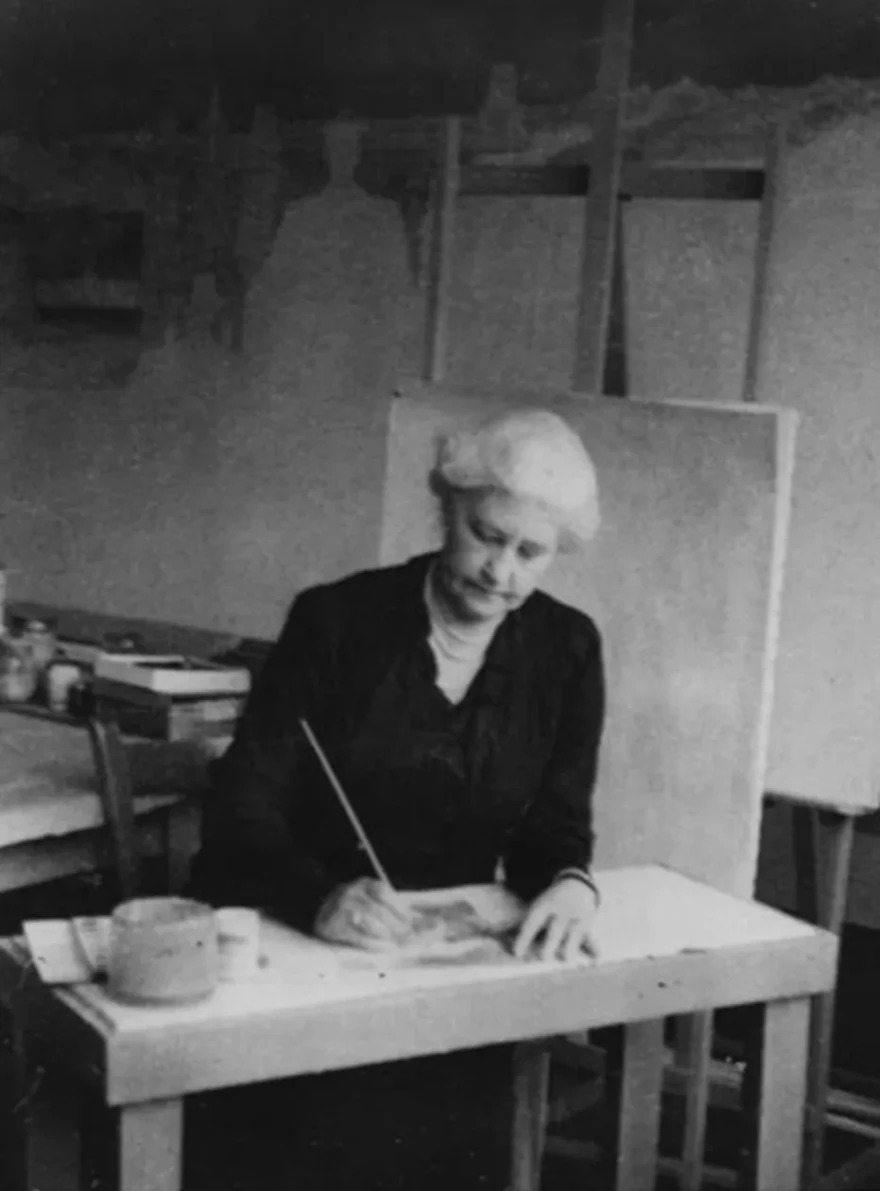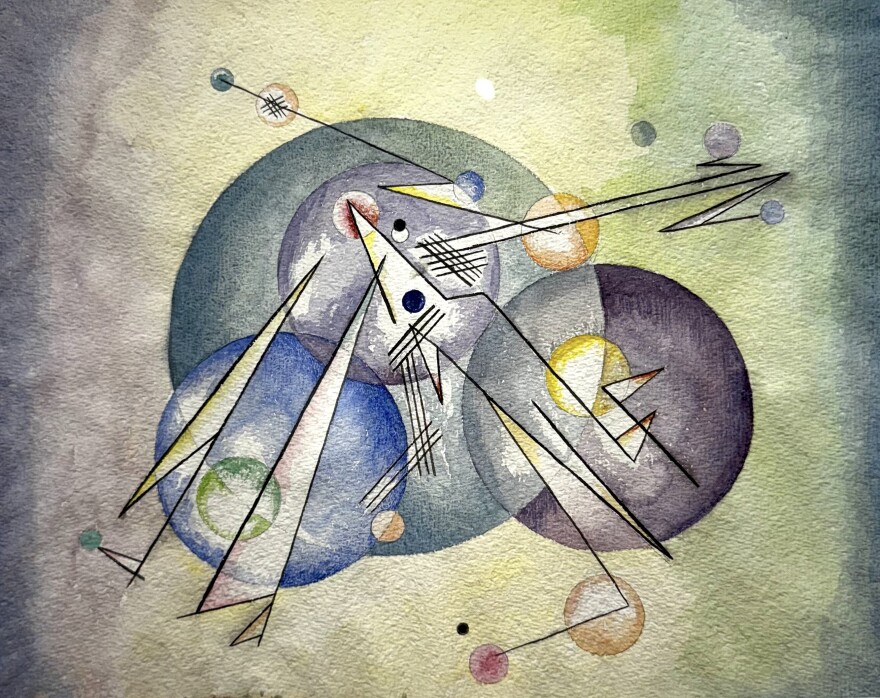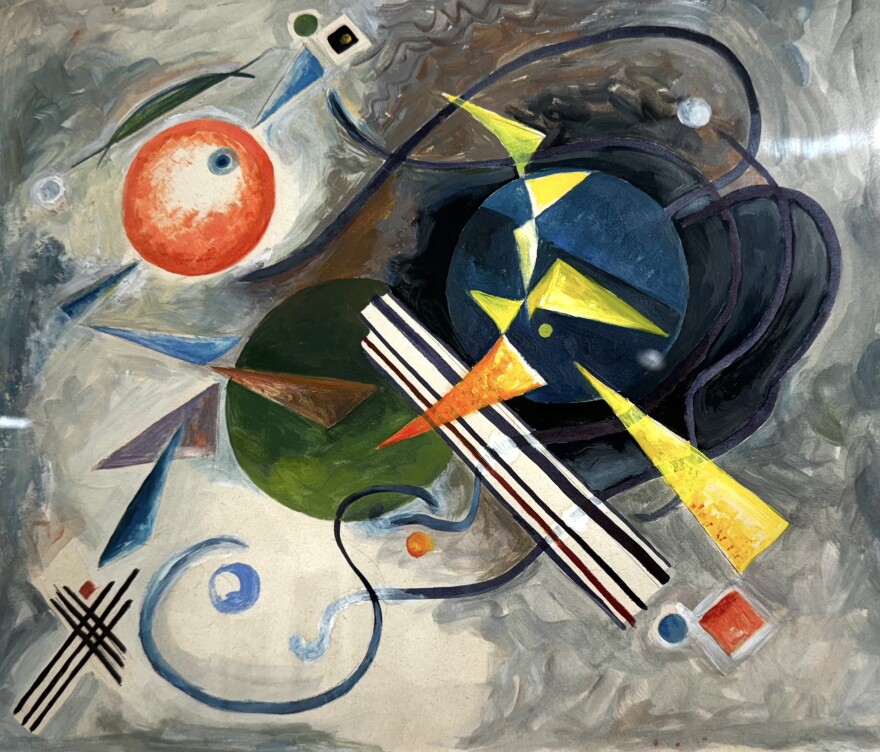Imagine stepping into a world where colors dance like musical secrets, and forms swirl like cosmic melodies. This is Maude Kerns: world-class painter, University of Oregon instructor, and now, the star of her own show. This is a glimpse into her soul in an intimate exhibition called “In the Realm of the Spirit.”

Have you ever wondered what it's like to be a woman in a man's world, trying to make your mark on the art scene? Maude Kerns did.
In this show, we get a window into Maude’s inner world not just through her non-objective paintings but through the showcased correspondence between her and Rolph Scarlett, a well-known painter from New York.

July 26, 1941
In her letters to Rolph, we come to know her doubts, her fears, and her ultimate triumph. In one 1941 letter, Maude worried about her work appearing too feminine. Rolph replied, “I hope never again will you feel that the feminine quality of your work is against you. Nonsense! I personally cannot see what you’re talking about!. Your things are boldly conceived and directly carried out.” Yay, Rolph, early feminist!

You may be interested in my observation notes for a few of these non-objective paintings as an example of one way to use close seeing and note-taking to sharpen your inner gaze. For example, for "Outer Space #4," (above) I took these observation notes:
- The image shows an abstract painting featuring a dynamic composition with geometric and organic shapes.
- The background consists of a deep blue hue that encompasses the central motifs.
- The painting employs bold colors such as red, yellow, pink, and various shades of blue that create a vibrant contrast.
- The forms seem to be interconnected with white linear elements that could suggest a sense of movement or connection between the shapes.
- Circular forms in green and brown tones add another layer of depth and complexity to the tableau.
- The overall effect is one of movement and rhythmic interaction between forms and colors, which may evoke a sense of playful dynamism or convey a metaphoric visual dance.
- The use of color blocking, contour lines, and the strategic placement of the shapes contribute to the lively composition of this abstract artwork.

One painting I loved (above) isn’t titled, but it is softer than her usual bright palette. The colors used are subtle and watercolor-like, with a blend of greens, blues, yellows, purples, and neutral tones giving it a dreamy, soft feel. Overall, the painting conveys a harmonious and delicate balance, reminiscent of a cosmic scene or a musical composition. The interplay of forms and colors suggests dynamism and a certain ethereal quality.
Here are my observation notes for the painting above. You can see how I used some of my notes to describe the work to you on the radio broadcast and how much I left out:
- The artwork depicted in this "Untitled" image is an abstract painting featuring a melange of geometric shapes and lines.
- The colors used are subtle and watercolor-like, with a blend of greens, blues, yellows, purples, and neutral tones giving it a dreamy, soft feel.
- The composition includes a series of overlapping circles and arcs that create a sense of depth and movement.
- There are also linear elements that resemble strings or wires stretching across the canvas and connecting different shapes.
- Some of these lines terminate in small, circular or oval forms, adding a suggestion of atoms or celestial bodies.
- Overall, the painting conveys a harmonious and delicate balance, reminiscent of a cosmic scene or a musical composition. The interplay of forms and colors suggests dynamism and a certain ethereal quality.

“In the Realm of the Spirit” awaits you at the Maude Kerns Art Center, ready to transport you to a world where the boundaries between artist and audience dissolve, and every brushstroke suggests a universe of cosmic meaning.

My Observation notes for "Untitled," (above).
- This is a vibrant, abstract painting featuring an array of geometric shapes and dynamic compositions.
- Dominating the center of the image is a large circular motif, part of which is painted red with a segmented pattern suggesting perhaps a sliced fruit or a geometric representation of an object.
- Radiating from this central point are various shapes in shades of blue, including what appears to be blade-like forms or fins, infusing a sense of motion into the piece.
- The background of the artwork is painted in muted tones, predominantly shades of purple and blue, with hints of warmer tones that add depth to the composition.
- In the upper left, two pale orbs float, possibly suggesting distant celestial bodies.
- A series of smaller, perfectly round shapes in reddish hues can be found towards the top right corner, which may represent smaller planets, bubbles, or simply abstract forms.
- The use of color is particularly notable, with contrasting hues that draw the eye and create a visual dialogue between warm and cool tones.
- The painting has an overall surreal and cosmic feel, suggesting themes of space, movement, and perhaps the celestial or metaphysical.
- The absence of recognizable figures or objects lends the painting a universal, timeless quality, allowing viewers to impart their personal interpretations upon the canvas.



